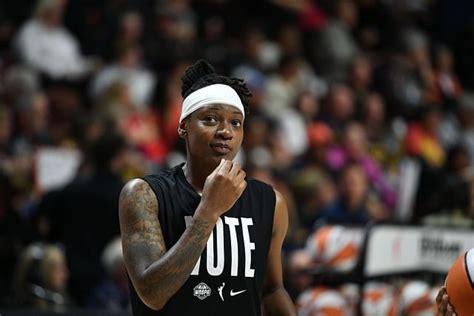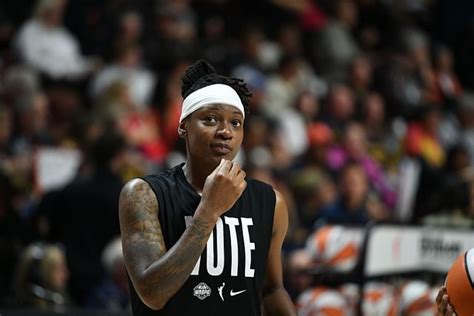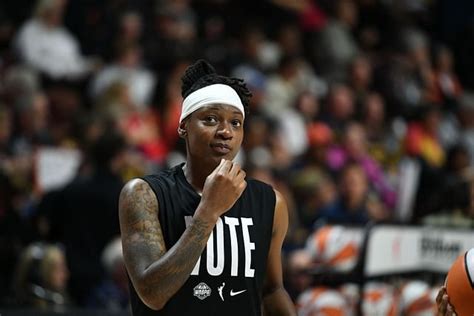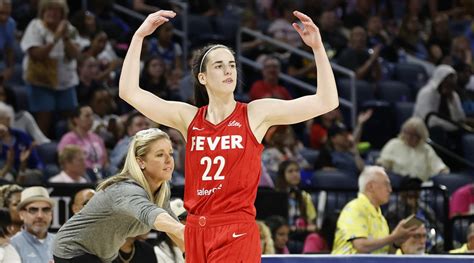
Caitlin Clark’s Indiana Fever teammate, Kristy Wallace, was ejected from Sunday’s game against the Seattle Storm following two technical fouls, hours after posting a cryptic message on social media referencing a “trust fall.” The post, and subsequent ejection, has ignited speculation amongst fans regarding team dynamics and potential tensions within the Fever organization.
Wallace received her first technical foul with 5:43 remaining in the second quarter and the second, resulting in her ejection, with 7:34 to go in the third. Before the game, Wallace posted on X, formerly Twitter, “What happens when you initiate a trust fall and no one catches you?” The timing of the post, coupled with her on-court ejection, has led to widespread conjecture about the intended meaning and potential implications for team morale.
The Indiana Fever ultimately lost to the Seattle Storm 103-88.
The Ejection and the Cryptic Post
Kristy Wallace’s ejection from Sunday’s game occurred after she received two technical fouls in relatively quick succession. The first came late in the second quarter, and the second, which triggered the ejection, occurred midway through the third. The circumstances surrounding the fouls were not explicitly detailed in initial reports, but their impact on the game was immediate, leaving the Fever shorthanded.
However, the real intrigue stemmed from Wallace’s pre-game social media activity. Her post, posing a question about a failed “trust fall,” immediately resonated with followers as potentially alluding to issues within the team. The phrase “trust fall” is often used metaphorically to represent reliance on others and the potential consequences when that reliance is misplaced. The lack of context in Wallace’s post only amplified the speculation.
The timing of the post is crucial. Posted hours before tip-off, it suggests that Wallace was already contemplating the situation, whatever it may be, before even stepping onto the court. This has led many to believe that the post was not a spur-of-the-moment reaction, but rather a calculated expression of her feelings.
The confluence of these two events – the cryptic post and the ejection – created a media firestorm. Fans, analysts, and commentators immediately began dissecting Wallace’s words and actions, searching for clues about the underlying issues. The incident occurred amidst already heightened scrutiny surrounding the Indiana Fever, given Caitlin Clark’s high profile and the team’s struggles to find consistency this season.
Team Dynamics Under Scrutiny
The Indiana Fever’s season has been marked by both immense hype and considerable challenges. The arrival of Caitlin Clark, the NCAA’s all-time leading scorer, brought unprecedented attention to the team and the WNBA as a whole. However, integrating Clark into the existing roster and building a cohesive team has proven difficult.
The Fever’s record reflects these struggles. They have faced inconsistencies on both ends of the court, and have often found themselves struggling to close out games. The pressure to perform has been immense, and the team has faced intense media scrutiny, leading to heightened sensitivity to any perceived internal conflicts.
Wallace’s cryptic post has intensified concerns about the team’s internal dynamics. Are there rifts within the roster? Is there a lack of trust between players and coaches? These are the questions that are now being asked. While it is impossible to definitively answer these questions based solely on Wallace’s post and ejection, the incident has undoubtedly raised red flags.
Team chemistry is crucial for success in any sport, especially in basketball, where collaboration and communication are essential. If players do not trust each other, or if there are unresolved conflicts within the team, it can be difficult to perform at a high level. The “trust fall” metaphor suggests a potential breakdown in this crucial element of team dynamics.
Caitlin Clark and the Pressure on the Fever
Caitlin Clark’s arrival in the WNBA has undeniably transformed the league. Her record-breaking college career and her exceptional talent have drawn millions of new fans to the sport. However, this increased attention has also placed immense pressure on Clark and the Indiana Fever.
Clark has faced a steep learning curve in the WNBA. The level of competition is significantly higher than in college, and she has had to adjust to new defensive strategies and a faster-paced game. She has also had to navigate the challenges of being a celebrity athlete, dealing with constant media attention and the expectations of fans.
The Fever, as a team, has also struggled to adapt to the increased scrutiny. Every game is now heavily analyzed, and every misstep is amplified. The pressure to win is immense, and this can create a stressful environment for players and coaches.
Wallace’s post and ejection must be viewed within this context. The Fever are a team under immense pressure, and any signs of internal conflict are likely to be magnified. It is possible that Wallace’s post was simply a reflection of this pressure, or that it was related to a specific incident within the team.
Clark has publicly addressed the importance of team chemistry and communication. She has emphasized the need for players to support each other and to work together towards a common goal. However, building this kind of team dynamic takes time and effort, and it is clear that the Fever are still in the process of developing this.
The Aftermath and Speculation
In the immediate aftermath of the game and Wallace’s ejection, social media platforms erupted with speculation and debate. Fans dissected the “trust fall” post, offering various interpretations of its meaning. Some speculated that it was a direct critique of the team’s coaching staff, while others suggested it reflected a broader sense of frustration with the team’s performance.
The lack of official comment from the Fever organization only fueled the speculation. Neither the team’s coaches nor management addressed the issue directly in post-game interviews, leaving fans and media to draw their own conclusions. This silence was interpreted by some as an attempt to downplay the incident, while others saw it as a sign of deeper internal problems.
Several sports analysts weighed in on the situation, offering their perspectives on the potential implications for the Fever’s season. Some argued that the incident was a minor blip that would quickly be resolved, while others warned that it could be a symptom of more serious underlying issues.
The incident also sparked a broader discussion about the pressures facing WNBA players, particularly those on high-profile teams like the Fever. Many commentators noted that the increased attention and scrutiny can take a toll on players’ mental and emotional well-being, potentially leading to conflicts and tensions within the team.
As of now, the exact meaning of Wallace’s post and the reasons behind her ejection remain unclear. Without further information from Wallace or the Fever organization, any interpretation remains speculative. However, the incident has undoubtedly cast a shadow over the team and raised questions about its internal dynamics.
Examining Kristy Wallace’s Career and Role
Kristy Wallace is a seasoned player who brings valuable experience to the Indiana Fever. Understanding her background and role on the team can provide additional context to the recent events.
Wallace, a native of Australia, has played professionally in both the WNBA and overseas. She was drafted by the Atlanta Dream in 2018 and has also played for the Sydney Uni Flames in the Women’s National Basketball League (WNBL) in Australia. She is known for her defensive abilities and her versatility as a player, capable of playing both guard positions.
In her role with the Indiana Fever, Wallace is primarily a role player, providing valuable minutes off the bench. She is known for her hustle, her defensive intensity, and her willingness to do the “dirty work” that doesn’t always show up in the box score. While she may not be a star player, she is considered a valuable asset to the team, providing depth and experience.
Wallace’s contribution often extends beyond her on-court performance. She is known for her positive attitude and her willingness to mentor younger players. Her experience and leadership can be valuable assets for a team that is still developing its identity.
Given her background and role, Wallace’s cryptic post and ejection are particularly surprising. As a veteran player, she is typically seen as a stabilizing force within the team. Her actions suggest that there may be deeper issues at play that are affecting even the most experienced members of the roster.
Potential Interpretations of the “Trust Fall” Metaphor
The “trust fall” metaphor is open to interpretation, and several potential meanings could be applied to the situation within the Indiana Fever.
- Lack of Support from Teammates: One interpretation is that Wallace feels unsupported by her teammates, both on and off the court. This could manifest in a variety of ways, such as a lack of assistance on defense, a failure to make the right pass on offense, or a general lack of camaraderie and encouragement.
- Disagreement with Coaching Decisions: Another possibility is that Wallace’s post is directed at the coaching staff, expressing frustration with their strategies or decisions. This could involve disagreements about playing time, offensive schemes, or defensive assignments.
- Frustration with Team Performance: The “trust fall” could also represent a broader sense of frustration with the team’s overall performance. Wallace may feel that the team is not living up to its potential and that there is a lack of accountability or commitment among some members of the roster.
- Personal Issues: It is also possible that the post is related to personal issues that Wallace is dealing with outside of basketball. While this may seem less likely given the timing of the post and the ejection, it cannot be completely ruled out.
- General Lack of Cohesion: Finally, the metaphor could simply be referring to a general lack of cohesion and trust within the team. The Fever are a relatively young team, and it takes time to build the kind of chemistry and trust that is necessary for success.
Ultimately, the true meaning of Wallace’s post remains a mystery. However, these potential interpretations highlight the range of issues that could be affecting the Indiana Fever.
The Indiana Fever’s Response (or Lack Thereof)
The Indiana Fever’s response to the incident has been notable for its absence. As of now, neither the team’s coaches nor management have issued any official statement addressing Wallace’s post or her ejection. This silence has only fueled speculation and intensified concerns about the team’s internal dynamics.
There are several possible reasons for the Fever’s lack of response. One possibility is that they are still gathering information and trying to understand the situation before making any public statements. Another is that they are attempting to downplay the incident and avoid further media attention.
However, the lack of communication can also be seen as a missed opportunity to address the concerns of fans and to reassure them that the team is working to resolve any internal issues. In the absence of official information, fans are left to rely on speculation and rumors, which can be damaging to the team’s reputation.
A more proactive approach would have been for the Fever to acknowledge the incident and to assure fans that they are taking it seriously. They could have also emphasized their commitment to building a positive and supportive team environment.
Moving Forward: Potential Solutions and Strategies
Regardless of the underlying cause of the incident, the Indiana Fever must take steps to address the concerns raised by Wallace’s post and ejection. Here are some potential solutions and strategies that the team could consider:
- Internal Communication: The most important step is to facilitate open and honest communication within the team. This could involve team meetings, individual counseling sessions, or other methods of encouraging players to express their concerns and frustrations.
- Team Building Activities: Engaging in team-building activities can help to foster a sense of camaraderie and trust among players. These activities could range from simple social gatherings to more structured exercises designed to improve communication and collaboration.
- Coaching Adjustments: If Wallace’s post is related to coaching decisions, the coaching staff may need to re-evaluate their strategies and communication style. This could involve seeking input from players, making adjustments to offensive or defensive schemes, or simply being more transparent about their decision-making process.
- Player Support: The Fever should ensure that players have access to the resources and support they need to deal with the pressures of being a professional athlete. This could include providing access to mental health professionals, offering counseling services, or simply creating a more supportive and understanding team environment.
- Public Relations: The Fever should consider issuing a statement addressing the incident and reassuring fans that they are committed to resolving any internal issues. This could help to quell speculation and restore confidence in the team.
- Address Team Chemistry Issues Head-On: The coaching staff and team leaders need to proactively identify and address any potential chemistry issues within the locker room. This requires fostering an environment where players feel comfortable expressing their concerns and working together to find solutions. Regular team meetings, open communication channels, and conflict resolution strategies can all be helpful in this regard.
- Re-evaluate Roles and Expectations: The coaching staff should clearly define each player’s role on the team and ensure that expectations are communicated effectively. This can help to reduce confusion and frustration, and it can also help players to feel more valued and appreciated.
- Focus on Team Goals: It is important for the Fever to maintain a focus on their overall team goals, rather than getting bogged down in individual concerns or conflicts. This can help to create a sense of shared purpose and to encourage players to work together towards a common objective.
- Leadership Development: The Fever should invest in leadership development programs for its players, particularly those who are seen as leaders within the team. This can help them to develop the skills and qualities necessary to effectively lead and motivate their teammates.
- Conflict Resolution Training: Providing conflict resolution training for players can help them to effectively manage and resolve disagreements within the team. This can reduce the likelihood of conflicts escalating and disrupting team chemistry.
- External Mediator: In some cases, it may be helpful to bring in an external mediator to help the team address its internal issues. A mediator can provide an objective perspective and facilitate communication between players and coaches.
- Address Social Media Usage: The team may need to establish guidelines for social media usage to prevent similar incidents in the future. While players have a right to express themselves, it is important to ensure that their social media activity does not negatively impact the team.
- One-on-One Meetings: Individual meetings between coaches and players can provide a safe space for players to voice concerns, ask questions, and receive feedback. These meetings can help to build trust and strengthen relationships.
The Importance of Context and Perspective
It is important to approach this situation with context and perspective. The Indiana Fever are a relatively young team that is still in the process of developing its identity. They have faced immense pressure this season, and it is not surprising that they have experienced some growing pains.
Wallace’s post and ejection are certainly cause for concern, but they should not be seen as evidence of a complete breakdown within the team. It is possible that the incident is simply a reflection of the challenges that the Fever are facing as they try to build a winning team.
It is also important to remember that professional athletes are human beings, and they are subject to the same emotions and frustrations as anyone else. They are under immense pressure to perform at a high level, and they are often scrutinized by the media and fans. It is important to give them the benefit of the doubt and to avoid jumping to conclusions based on limited information.
FAQ Section
1. What exactly did Kristy Wallace post on social media before the game?
Kristy Wallace posted on X (formerly Twitter), “What happens when you initiate a trust fall and no one catches you?” This cryptic message, posted hours before the Indiana Fever’s game against the Seattle Storm, is what sparked widespread speculation regarding team dynamics.
2. Why was Kristy Wallace ejected from the game against the Seattle Storm?
Kristy Wallace was ejected from the game after receiving two technical fouls. The first technical foul occurred with 5:43 remaining in the second quarter, and the second, leading to her ejection, occurred with 7:34 left in the third quarter. The exact reasons for the technical fouls have not been explicitly detailed, but they occurred after Wallace made the mentioned cryptic post.
3. How has the Indiana Fever organization responded to the incident?
As of now, the Indiana Fever organization has not released any official statement regarding Kristy Wallace’s post or her ejection. This silence has fueled speculation and added to the uncertainty surrounding the situation.
4. How is Caitlin Clark handling the pressure and scrutiny surrounding the Indiana Fever?
Caitlin Clark has publicly emphasized the importance of team chemistry and communication, acknowledging the challenges of building a cohesive team in the WNBA. She has also addressed the need for players to support each other amidst the intense pressure and media attention. While she hasn’t specifically addressed Wallace’s situation, she has been consistent in promoting team unity.
5. What are some possible interpretations of Kristy Wallace’s “trust fall” metaphor?
Several interpretations exist: a lack of support from teammates, disagreements with coaching decisions, frustration with team performance, personal issues unrelated to the team, or a general lack of cohesion within the Indiana Fever. The exact meaning remains speculative without further clarification from Wallace or the team.









